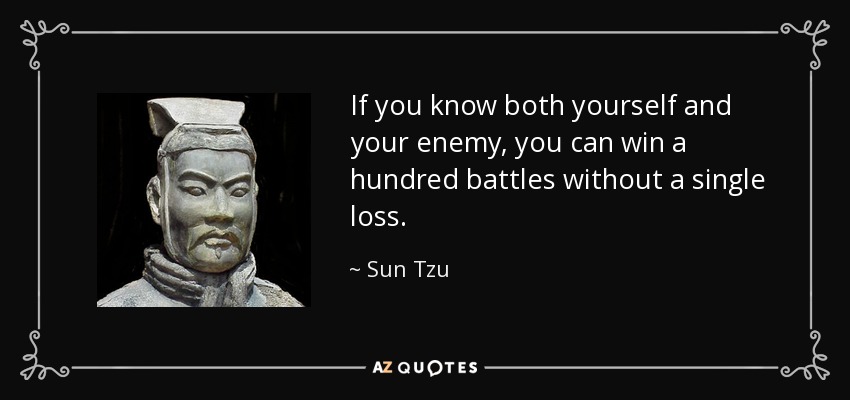If you know the enemy and know yourself, you need not fear the result of a hundred battles. If you know yourself but not the enemy, for every victory gained you will also suffer a defeat. If you know neither the enemy nor yourself, you will succumb in every battle.
Sun Tzu, The Art of War
The Challenges
Have you experienced the following type of anxiety about interviews?
- How long and detail should I get when answering this question?
- Should I ask this clarification question?
- Should I mention this example in this question?
- What aspects should I focus on when answering the question?
Ultimately, these boils down to the question of “what does the interviewer expect me to do“. Knowing this is key to nail the interview. Below we will peel the onions and answer this question.
The Strategy

A very useful strategy is to think in the interviewers’ shoes. It’s easier said than done. Let’s break it down into a few important areas below. The goal is that after reading through this, you have clearer understanding of the interviewers’ point of view and thus can better structure your interview preparation and optimize your performance during the interviews.
Expectation Of The Role
The first obvious place to read about the expectation of the role is job description. You can pick up key information whether the role is heavy on building new things, maintaining existing things, integrating things, cross team collaboration, and so on. Big companies with lots of openings often use a generic job description that you can’t read too much specifics out of it. In that case, refer to job related online community to read about discussions about the particular company and their general expectation of candidates.
Recruiters are also great source of information to learn about the specific expectation of the role. You can ask the recruiters questions like “is this a new HC or refill of an existing role”, “specific goals for this role to achieve”, “is this role more focused on solving hard problems in a deep area or driving a lot of cross team collaboration”, and so on.
If you are lucky to have an informational chat with the hiring manager, that’s a perfect opportunity to learn more specifics of the role too. Knowing specific expectations of the role helps you to tailor your interview answers to highlight the points that are most relevant to the role so you appear the best custom fit for the role. For example, if a product role has full stack scope that touches both backend and end user facing UX, your previous full stack experience and your philosophy of balancing backend and front end product development will make you stand out.
Signals Interviewers Are Looking For
From interviewers’ point of view, at a very short period of time (e.g., 45 min or 60 min), they need to form an opinion if the candidate is the right fit for the role. Each interviewer is assigned a specific area of assessment and they each have a number of signals to pick up. If you did your preparation really well (refer to my previous posts about it) you can sense the kind of signals the interviewer is looking for. For example, for a design question, one important signal is your ability of applying a systematic approach to analyze the product design from target customer, pain points, competitive landscape, all the way to requirements, features, milestones, cost, and so on. If you feel the interviewer’s problem statement is over simplified, he/she might be pick up signals whether you can effectively communicate and clarify and eventually get to clarity in terms of requirements.
Since both yours and the interviewer’s goal is to pick up positive signals during the short period of time, avoid diving into any area too deep and spend too much time, unless the interviewer clearly asked you to do so. Some candidates tend to talk a lot non-stop either because they want to make sure all related info is presented so nothing is missed or because filling the time helps avoid harder question at the end of the interview. This is a bad idea, because when the interviewer can’t get all the signals necessary to form a confident hiring decision, the default is “no hire”.
What if in some situation, the meat of your answer to provide strong signals is a lengthy story? Use the top down approach. Describe the story in high level and tell the interviewer you successfully applied certain leadership principle or achieved certain goals and whether you have 5 min time to elaborate on that. Having this collaborative approach to manage the interview timing together with your interviewer makes sure the interviewer get all the signals plus a bonus signal of effective collaboration.
Interviewers’ Concerns of Career Transition Candidates
For career transition candidates, there is another layer of assessment in addition to the assessment purely on the job role itself. This is because unleaning takes efforts and it’s a risk for the employer whether the candidate can adapt to the new role.
For example, when an engineer is applying for a product manager role, the additional concern is how much mindset shift and unlearn does the candidate have to go through to become a successful PM. Engineers are usually heads down type of personality and base their work on specifications instead of deep understanding of users, however PMs should be customer obsessed and have a lot of user empathy. Engineers are usually less of people persons, however as product leaders, PMs are the lynchpins of multi-disciplinary teams.
Another example, when an engineer is applying for an engineering manager role, the additional concern is whether the engineer is ready to support others to grow and achieve goals through others. Many engineers misunderstood engineering manager role as the only career path in engineering. If that is the only motivation and they are not ready for the transition, it is a big risk for the employer.
For career transition candidates, from the interviewer’s point of view, there should be strong signals why the candidate is ready for the transition. There are 2 types of examples you can prepare for this:
- Your journey to committing to the career transition. Describe the major events or your mindset changes that established your motivation for the career transition. Also demonstrate what learning did you do in preparation for the transition, e.g., taking trainings, doing side projects, volunteering, etc. This helps convince the interviewer that you made the conscious decision.
- Your real world experience that validated your decision of career transition. You don’t want to appear like after you made up your mind on the career transition the next action was to apply for a job. Ideally, you tried to take on new responsibilities informally without actually making the switch to validate via real world experience that your career transition was a sound decision. For example, for an engineer who wants to transition to engineering manager role, you could try and succeed on tech lead role (leading a small team of people), mentor role (coaching and helping others career growth), and so on.
Conclusion
Think though the lens of the interviewers. Help them to get all the signals they need to vote “hire” for you.

